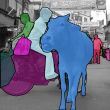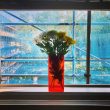see German post.
December 22nd, 2020 — Archive / Showcase Organized by the Berliner Gazette at Haus der Statistik from November 7 - 28, 2020. A cooperation with HaFI.
Organized by the Berliner Gazette at Haus der Statistik from November 7 - 28, 2020. A cooperation with HaFI.
see German post.
November 28th, 2020 — Archive / ShowcaseHaFI publications in Korean and Turkish
November 16th, 2020 — Projects / Publication However, it’s okay to have Game Night once in a while, because it allows us to socialize. Using wrinkles to toggle dry light. By DEATH CLASS
However, it’s okay to have Game Night once in a while, because it allows us to socialize. Using wrinkles to toggle dry light. By DEATH CLASS
 A glimpse into the genesis of IMAGES OF THE WORLD AND THE INSCRIPTION OF WAR (1988).
To be released shortly, HaFI 013 can already be ordered at Motto Books.
A glimpse into the genesis of IMAGES OF THE WORLD AND THE INSCRIPTION OF WAR (1988).
To be released shortly, HaFI 013 can already be ordered at Motto Books.
 Organized by the Berliner Gazette, the Winter School “Silent Works” investigates possibilities for re-inventing ‘the school’ along the lines of ‘the factory.’
Organized by the Berliner Gazette, the Winter School “Silent Works” investigates possibilities for re-inventing ‘the school’ along the lines of ‘the factory.’
... regarding aerial reconnaisance photographs of Auschwitz-Birkenau taken during World War II
October 30th, 2020 — Archive / Showcase The production of knowledge, fake news, has no source, no center. There is no author. By VLADIMIR MILADINOVIĆ and STEPHENIE YOUNG
The production of knowledge, fake news, has no source, no center. There is no author. By VLADIMIR MILADINOVIĆ and STEPHENIE YOUNG
see German post.
September 30th, 2020 — Archive / Showcase “The game on TV is Tom and Jerry, the game in the EU is refugees and the police.” By NIKA AUTOR
“The game on TV is Tom and Jerry, the game in the EU is refugees and the police.” By NIKA AUTOR
 The current crisis is making many of us increasingly amenable to other forms of more mundane automation. By JOEL McKIM
The current crisis is making many of us increasingly amenable to other forms of more mundane automation. By JOEL McKIM
With a donation you can support our work on the English autobiography.
September 15th, 2020 — About us / Support Bielefeld University enables the further production of preview films from the filmography of Harun Farocki.
Bielefeld University enables the further production of preview films from the filmography of Harun Farocki.
 The Open Call runs until September 25, 2020.
The Open Call runs until September 25, 2020.
 A panel discussion about Berlin vs. Amazon and the Berliner Gazette's Silent Works project, a partnership with HaFI.
A panel discussion about Berlin vs. Amazon and the Berliner Gazette's Silent Works project, a partnership with HaFI.
 HaFI participation with a panel dedicated to Farocki and his TV collaboration with the WDR.
HaFI participation with a panel dedicated to Farocki and his TV collaboration with the WDR.
 How can, how should these images be looked at? And how do they unsettle the contemporary gaze?
How can, how should these images be looked at? And how do they unsettle the contemporary gaze?
 If we have reason to panic, what do we do with it, where do we go? Again, how do we get out of here? By DANIEL A. BARBER
If we have reason to panic, what do we do with it, where do we go? Again, how do we get out of here? By DANIEL A. BARBER
See German post.
August 30th, 2020 — Archive / Showcase More people are having powerful dreams that get their attention than in typical times. By JORDAN BASEMAN
More people are having powerful dreams that get their attention than in typical times. By JORDAN BASEMAN
 We know that their echoes will continue reverberating in the system’s cracks, each time becoming louder and more visible. By ARTS CATALYST
We know that their echoes will continue reverberating in the system’s cracks, each time becoming louder and more visible. By ARTS CATALYST
 Bring it on (bring it all up) say the cards, and let everything bleed ... By PLASTIQUE FANTASTIQUE
Bring it on (bring it all up) say the cards, and let everything bleed ... By PLASTIQUE FANTASTIQUE
 Remains of magnolias blown away/Branches fall. Power out. By ALEXANDRA DÉLANO ALONSO
Remains of magnolias blown away/Branches fall. Power out. By ALEXANDRA DÉLANO ALONSO
![]() There is something visceral about the refusal to place a protective barrier across the mouth and nose, and to do so in the name of “freedom” or “just because.” By KIMBERLY JUANITA BROWN
There is something visceral about the refusal to place a protective barrier across the mouth and nose, and to do so in the name of “freedom” or “just because.” By KIMBERLY JUANITA BROWN
 The kind of hope that I will speak of here is immanent, yet precisely as the immanent force of finitude. By JOHN PAUL RICCO
The kind of hope that I will speak of here is immanent, yet precisely as the immanent force of finitude. By JOHN PAUL RICCO
see German post.
July 16th, 2020 — Archive / Showcase The psychology of finite resources can only exist under the conditions of oppression, so let's burn down the master’s house and its tools. By JANINE FRANCOIS
The psychology of finite resources can only exist under the conditions of oppression, so let's burn down the master’s house and its tools. By JANINE FRANCOIS
 It is remarkable how much we can discover in our immediate spaces when our attention has not been captured by the constant haste of our responsibilities. By EDINSON ARROYO
It is remarkable how much we can discover in our immediate spaces when our attention has not been captured by the constant haste of our responsibilities. By EDINSON ARROYO
See German post.
June 30th, 2020 — Archive / Showcase I see ghost bodies that are trapped into an unattainable time-space of which the image’s virtuality reinforces the feeling. By VANESSA CIMORELLI
I see ghost bodies that are trapped into an unattainable time-space of which the image’s virtuality reinforces the feeling. By VANESSA CIMORELLI
 Burdened with a doubtful reputation, the practice and attitude of escapism may eventually prove to hold an adequate response to the dire realities of the present and the time to come. By TOM HOLERT
Burdened with a doubtful reputation, the practice and attitude of escapism may eventually prove to hold an adequate response to the dire realities of the present and the time to come. By TOM HOLERT
 For the art school to survive, let alone thrive, we will have to adjust not only our tactics for working and teaching, but also for industrial action. By JULIET JACQUES
For the art school to survive, let alone thrive, we will have to adjust not only our tactics for working and teaching, but also for industrial action. By JULIET JACQUES
 We read Arendt’s words as an undeniable exhortation to what may be may transpire when the economic and social crisis exacerbated by Covid-19 soon manifests in full. By LUIS FEDUCHI
We read Arendt’s words as an undeniable exhortation to what may be may transpire when the economic and social crisis exacerbated by Covid-19 soon manifests in full. By LUIS FEDUCHI
 The whole operation appears intrinsically flawed, reflecting a collective colour-blind attitude that has become particularly visible in light of recent events. By ALESSANDRA FERRINI
The whole operation appears intrinsically flawed, reflecting a collective colour-blind attitude that has become particularly visible in light of recent events. By ALESSANDRA FERRINI
 The transient nature of knowledge production today, whether in the solution-averse casualised university or the history-averse design program, is a matter of its exacerbating devaluation. By BAHAR NOORIZADEH
The transient nature of knowledge production today, whether in the solution-averse casualised university or the history-averse design program, is a matter of its exacerbating devaluation. By BAHAR NOORIZADEH
 The more piercingly the crisis sirens howl, the greater the hunger for dedicated emergency workers, determined people of action and indomitable freedom fighters. By ULRICH BRÖCKLING
The more piercingly the crisis sirens howl, the greater the hunger for dedicated emergency workers, determined people of action and indomitable freedom fighters. By ULRICH BRÖCKLING
 The world sleeps, the axes change. The world wakes up, and the sun falls on empty streets. By ANDREAS PHILIPPOPOULOS-MIHALOPOULOS
The world sleeps, the axes change. The world wakes up, and the sun falls on empty streets. By ANDREAS PHILIPPOPOULOS-MIHALOPOULOS
 How can we create work from within these imposed conditions and reflect on them at the same time? By PIL AND GALIA KOLLECTIV
How can we create work from within these imposed conditions and reflect on them at the same time? By PIL AND GALIA KOLLECTIV
 If we can collectively grasp this narrative, kick them out as soon as possible we can have it all!!!! By HANA NOORALI and LYNTON TALBOT
If we can collectively grasp this narrative, kick them out as soon as possible we can have it all!!!! By HANA NOORALI and LYNTON TALBOT
 I couldn’t help but question, if bringing our bodies together in this way plays into the logic of resilience measures the British government has come to calculate as necessary collateral damage for the UK economy to start again? By HELENE KAZAN
I couldn’t help but question, if bringing our bodies together in this way plays into the logic of resilience measures the British government has come to calculate as necessary collateral damage for the UK economy to start again? By HELENE KAZAN
 In its new blanket use, it points to medical conditions, chronic illnesses and disabilities that, in combination with age, we are told, are the real factors determining the death of thousands of people from the virus. By ELISA ADAMI
In its new blanket use, it points to medical conditions, chronic illnesses and disabilities that, in combination with age, we are told, are the real factors determining the death of thousands of people from the virus. By ELISA ADAMI
See German post.
May 30th, 2020 — Archive / Showcase Social proximity at an ideological level may, thanks to those who must necessarily remain physically proximate in medical and care situations, protect people by enabling physical distance. By DEAN KENNING
Social proximity at an ideological level may, thanks to those who must necessarily remain physically proximate in medical and care situations, protect people by enabling physical distance. By DEAN KENNING
 Experimental filmmaker Cathy Lee Crane (U.S.A.) is the fourth guest of the Harun Farocki Residency.
Experimental filmmaker Cathy Lee Crane (U.S.A.) is the fourth guest of the Harun Farocki Residency.
 A dossier consisting of documents and images on the "prison images" complex from the HaFI archive, compiled by HaFI.
A dossier consisting of documents and images on the "prison images" complex from the HaFI archive, compiled by HaFI.
 The issue #109 Navigation Beyond Vision II of the e-flux journal is now online.
The issue #109 Navigation Beyond Vision II of the e-flux journal is now online.
 Hidden curricula, nudging regimes, governmentalities—they are coming to the fore now, accruing obscene visibility in a big stand-off between liberal individualism and uniformizing state rule. By TOM HOLERT
Hidden curricula, nudging regimes, governmentalities—they are coming to the fore now, accruing obscene visibility in a big stand-off between liberal individualism and uniformizing state rule. By TOM HOLERT
 Alongside these ‘necro-visualisations’ of human tragedy, the concept of the model cuts across the public imagination as a harbinger of what might be and what was. By TOM CORBY
Alongside these ‘necro-visualisations’ of human tragedy, the concept of the model cuts across the public imagination as a harbinger of what might be and what was. By TOM CORBY
 Comparing the corona-phenomena to previous epidemic occurrences allows us to gain a grain of understanding and to make sense of the void, of absent bodies. By ANTOINE SIMEAO SCHALK
Comparing the corona-phenomena to previous epidemic occurrences allows us to gain a grain of understanding and to make sense of the void, of absent bodies. By ANTOINE SIMEAO SCHALK
 The ‘great withdrawal’ has made the circulations that make up subject-object relations almost brutally concrete. By LINA HAKIM
The ‘great withdrawal’ has made the circulations that make up subject-object relations almost brutally concrete. By LINA HAKIM
 The mines are exploited and emptied. There is a lacuna—left as a poisonous gift of modernity. Debris next to a village. Next to my village. By VINIT AGARWAL
The mines are exploited and emptied. There is a lacuna—left as a poisonous gift of modernity. Debris next to a village. Next to my village. By VINIT AGARWAL
 Those resistant to the idea of sortition as a substitute for election are often surprised when it is made clear to them that the use of random selection is a standard and reliable practice in many representative democracies. By LUIS FEDUCHI
Those resistant to the idea of sortition as a substitute for election are often surprised when it is made clear to them that the use of random selection is a standard and reliable practice in many representative democracies. By LUIS FEDUCHI
 Window Poster # 1 + Colouring-in Version, May 2020. Poster designed by JAMES SMITH
Window Poster # 1 + Colouring-in Version, May 2020. Poster designed by JAMES SMITH
 Calling the hospitals by the person epitomising modern nursing was not a simple misnomer but a poor attempt at dressing up a wolf bred by austerity in the clothes of a sheep versed in historical knowledge. By JELENA STOJKOVIC
Calling the hospitals by the person epitomising modern nursing was not a simple misnomer but a poor attempt at dressing up a wolf bred by austerity in the clothes of a sheep versed in historical knowledge. By JELENA STOJKOVIC
 Our own cells split the foreign intruder, allowing it to contaminate our body, turning ourselves into our own evil twins. By LANA LIN and H. LAN THAO LAM
Our own cells split the foreign intruder, allowing it to contaminate our body, turning ourselves into our own evil twins. By LANA LIN and H. LAN THAO LAM
 It turns out that Seligman had chronicled the psychic wounds of colonialism, revealing a political order fundamentally at odds with Britain’s self-understanding. By MARGARETA KERN
It turns out that Seligman had chronicled the psychic wounds of colonialism, revealing a political order fundamentally at odds with Britain’s self-understanding. By MARGARETA KERN
 They have recorded the song in Zulu, each vocalist recording in their own home and supplying these voice-messages to be incorporated into this new rendition of the song. By PHILIP MILLER
They have recorded the song in Zulu, each vocalist recording in their own home and supplying these voice-messages to be incorporated into this new rendition of the song. By PHILIP MILLER
 "Once the bats were trapped, the researchers took blood and saliva samples, as well as fecal swabs." By TOM HOLERT
"Once the bats were trapped, the researchers took blood and saliva samples, as well as fecal swabs." By TOM HOLERT
 The emergency measures are rules of composition. By DAVE BEECH
The emergency measures are rules of composition. By DAVE BEECH
 Really: that brachiosaurus-sized crane puts time into perspective, making more tangible the way the world may have looked when it teemed with life at that scale. By SARA BLAYLOCK
Really: that brachiosaurus-sized crane puts time into perspective, making more tangible the way the world may have looked when it teemed with life at that scale. By SARA BLAYLOCK
 Appropriating the simplicity of play, it seems, might come with consequences. By ERAY ÇAYLI
Appropriating the simplicity of play, it seems, might come with consequences. By ERAY ÇAYLI
How tired the world has become of this human and its spectre. By YVE LOMAX
May 5th, 2020 — Rosa Mercedes / 02![]() The confusion and turbulence of COVID: that is the place we all share now. It’s the first movement of the sonata, grave. By PATRICIA R. ZIMMERMANN
The confusion and turbulence of COVID: that is the place we all share now. It’s the first movement of the sonata, grave. By PATRICIA R. ZIMMERMANN
 As a society, in a way unlike any other, the question is out in the open: what does it mean to consider the lives of others? By ANDREA LUKA ZIMMERMAN
As a society, in a way unlike any other, the question is out in the open: what does it mean to consider the lives of others? By ANDREA LUKA ZIMMERMAN
![]() Perhaps we do not need a critique of the power-relation in “giving a voice” but of the very demand for a body to produce a recognizable voice in the first place. By ALEXANDRA PIRICI
Perhaps we do not need a critique of the power-relation in “giving a voice” but of the very demand for a body to produce a recognizable voice in the first place. By ALEXANDRA PIRICI
 The non-human futures of the SARS-CoV-2 virus will not be written to be stored in the digital archive. Its trans-species assemblage will have had vectors that are imperceptible to us today. By AMIT S. RAI
The non-human futures of the SARS-CoV-2 virus will not be written to be stored in the digital archive. Its trans-species assemblage will have had vectors that are imperceptible to us today. By AMIT S. RAI
 I see my dry hands, clean as hell, as never before. And I see fear in a handful of sanitizer. A dispatch from Warsaw. By KASIA BOJARSKA
I see my dry hands, clean as hell, as never before. And I see fear in a handful of sanitizer. A dispatch from Warsaw. By KASIA BOJARSKA
We would be very interested in getting this stock from you. Please let us know if it is still available.
April 30th, 2020 — Archive / Showcase We, survivors, were born for this crisis. By OREET ASHERY
We, survivors, were born for this crisis. By OREET ASHERY
 April 2020 saw gatherings of the American right-wing that declared they demand to “re-open the economy,” as they call it. These protests were payed for by the wealthiest donors to the US Republican party. By JOSHUA SIMON
April 2020 saw gatherings of the American right-wing that declared they demand to “re-open the economy,” as they call it. These protests were payed for by the wealthiest donors to the US Republican party. By JOSHUA SIMON
 We may ask, whether in the current, transitional period of social distancing, where intermingling, contact and proximity have become anathema, the notion of entanglement is already accruing a new set of connotations, regardless whether we understand it in a concrete or metaphorical sense. By ERIC C. H. DE BRUYN
We may ask, whether in the current, transitional period of social distancing, where intermingling, contact and proximity have become anathema, the notion of entanglement is already accruing a new set of connotations, regardless whether we understand it in a concrete or metaphorical sense. By ERIC C. H. DE BRUYN
 "[...] a tsunami of derivative, cliche ads all within a week of one another. It's not a conspiracy - but perhaps a sign that it's time for something new" (Microsoft Sam)
"[...] a tsunami of derivative, cliche ads all within a week of one another. It's not a conspiracy - but perhaps a sign that it's time for something new" (Microsoft Sam)
 I lift one side of the headphones away from my left ear dispelling the patch of workplace that has been mapped onto the kitchen table for the last hour or so. By JON THOMSON and ALISON CRAIGHEAD
I lift one side of the headphones away from my left ear dispelling the patch of workplace that has been mapped onto the kitchen table for the last hour or so. By JON THOMSON and ALISON CRAIGHEAD
 Biocontainment suits, biological hoods, and isolation tents create physical separation, but allow for visual access, between the infected and the hygienic. By SHANNON MATTERN
Biocontainment suits, biological hoods, and isolation tents create physical separation, but allow for visual access, between the infected and the hygienic. By SHANNON MATTERN
 "In chaos causality is lost, strategy and leadership no longer work as well, and we are left powerless." By TOM HOLERT
"In chaos causality is lost, strategy and leadership no longer work as well, and we are left powerless." By TOM HOLERT
 A small selection of texts written by the outstanding film critic and translator Frieda Grafe, complemented by a speech from Harun Farocki.
A small selection of texts written by the outstanding film critic and translator Frieda Grafe, complemented by a speech from Harun Farocki.
Is the sender genuinely asking me if I am well or safe or healthy? By DANAH ABDULLA
April 22nd, 2020 — Rosa Mercedes / 02 By a pupil at The Meadows Primary School, Lincoln, with RUTH EWAN
By a pupil at The Meadows Primary School, Lincoln, with RUTH EWAN
![]() The choices of headlines and visual artwork reflect the editorial and national context of each magazine.
The choices of headlines and visual artwork reflect the editorial and national context of each magazine.
 He was let down by both governments… By JORDAN McKENZIE
He was let down by both governments… By JORDAN McKENZIE
 "She is wearing a lab coat and a face mask and is saying, in the softest tone possible, that she is about to take a nasal swab to test for the virus. It’s scary and soothing at the same time." By TOM HOLERT
"She is wearing a lab coat and a face mask and is saying, in the softest tone possible, that she is about to take a nasal swab to test for the virus. It’s scary and soothing at the same time." By TOM HOLERT
 (...) how and where am i supposed to read the nuances by which I understand the world (...) By TERESA CISNEROS
(...) how and where am i supposed to read the nuances by which I understand the world (...) By TERESA CISNEROS
 The background and experience from which the new instructional visuals on the coronavirus crisis are being produced, inform the reduction guided by notions of didactic efficiency. By TOM HOLERT
The background and experience from which the new instructional visuals on the coronavirus crisis are being produced, inform the reduction guided by notions of didactic efficiency. By TOM HOLERT
 Media corporations will likely leverage the CoVid-19 crisis to insist that ubiquitous high-bandwidth media constitute an essential service. By LAURA U. MARKS
Media corporations will likely leverage the CoVid-19 crisis to insist that ubiquitous high-bandwidth media constitute an essential service. By LAURA U. MARKS
 In the corona triage the temporality of field surgery and the asymmetrical chronopolitics of age cohort, class affiliation and racial predicament meet in a new constellation. By TOM HOLERT
In the corona triage the temporality of field surgery and the asymmetrical chronopolitics of age cohort, class affiliation and racial predicament meet in a new constellation. By TOM HOLERT
 Interaction designer Christian Lässer is able to render evident (and visible) how the topic of the epidemic has gradually taken possession of Die Zeit – up to the full blown monopolization of its editorial content.
Interaction designer Christian Lässer is able to render evident (and visible) how the topic of the epidemic has gradually taken possession of Die Zeit – up to the full blown monopolization of its editorial content.
 It seems to me as if theoretical persuasions are now being confirmed not only in practice, but literally embodied. By JAN DISTELMEYER
It seems to me as if theoretical persuasions are now being confirmed not only in practice, but literally embodied. By JAN DISTELMEYER
 Shouldn’t this crisis demand an urgent politics of the domestic, specifically of those who have the privilege to #stayathome? By DOREEN MENDE
Shouldn’t this crisis demand an urgent politics of the domestic, specifically of those who have the privilege to #stayathome? By DOREEN MENDE
 There is "a good chance that the large-scale experimentation with telepresence, which has long met with much resistance, will encourage its lasting adoption" (André Gunthert). By TOM HOLERT
There is "a good chance that the large-scale experimentation with telepresence, which has long met with much resistance, will encourage its lasting adoption" (André Gunthert). By TOM HOLERT
 The Coronacrisis cover artwork of the French daily newspaper Libération, starting with the issue of January 23, continuing without interruption from March 9 to ...
The Coronacrisis cover artwork of the French daily newspaper Libération, starting with the issue of January 23, continuing without interruption from March 9 to ...
 The V-shape recession, a sudden deep trough, followed by a quick surge, for few, and the Germans with their economic strength and infamouis intransigence when it comes to economic solidarity most certainly among them, is becoming analogous to the V-ictory-sign (in the wake of the V-irus ...) By TOM HOLERT
The V-shape recession, a sudden deep trough, followed by a quick surge, for few, and the Germans with their economic strength and infamouis intransigence when it comes to economic solidarity most certainly among them, is becoming analogous to the V-ictory-sign (in the wake of the V-irus ...) By TOM HOLERT
 It seems as if Suely Rolnik has already in 2005 anticipated the effects of the virus that is currently chokeholding the world: For the already discriminated minorities, including the predominantly black service providers and domestic workers recruited from the favelas, are now considered particularly at risk. By SABETH BUCHMANN
It seems as if Suely Rolnik has already in 2005 anticipated the effects of the virus that is currently chokeholding the world: For the already discriminated minorities, including the predominantly black service providers and domestic workers recruited from the favelas, are now considered particularly at risk. By SABETH BUCHMANN
see German Post
March 31st, 2020 — Archive / Showcase The retreat into "solitary facelessness," however, may have different faces, depending on local histories and urgencies. By TOM HOLERT
The retreat into "solitary facelessness," however, may have different faces, depending on local histories and urgencies. By TOM HOLERT
 If anything could stand-in as a primary culprit in the rapid spread of the COVID-19 virus that is circling the globe with seemingly unprecedented speed, it might be the jet plane. By VANESSA SCHWARTZ
If anything could stand-in as a primary culprit in the rapid spread of the COVID-19 virus that is circling the globe with seemingly unprecedented speed, it might be the jet plane. By VANESSA SCHWARTZ
 Today: Le Petit Journal (February 1911), covering the devastating 1910/1911"pest" in Manchuria
Today: Le Petit Journal (February 1911), covering the devastating 1910/1911"pest" in Manchuria
 Albeit everyone seems to believe otherwise, every crisis has a history. Hence this crisis has a history as well. BY MARK TERKESSIDIS
Albeit everyone seems to believe otherwise, every crisis has a history. Hence this crisis has a history as well. BY MARK TERKESSIDIS
 Today: a reportage on the cholera in Hamburg in 1892 from the Illustrated London News.
Today: a reportage on the cholera in Hamburg in 1892 from the Illustrated London News.
 In our compromised and entangled ways, we try to keep going, trying to transmutate heteronomy into shades of autonomy. By SVEN LÜTTICKEN
In our compromised and entangled ways, we try to keep going, trying to transmutate heteronomy into shades of autonomy. By SVEN LÜTTICKEN
 First delivery: an illustrated reportage on the cholera in Naples in 1884 from the Illustrated London News.
First delivery: an illustrated reportage on the cholera in Naples in 1884 from the Illustrated London News.
 Beneath the current debates and statements about the "costs" of lockdowns and social distancing, beneath Trumpian disengagement from medical cure (in his attempt to decouple the health catastrophe of the pandemic from the "problem" of ecomomic repression and de-growth), there lurks the most vicious vision/version of "therapeutic nihilism." By TOM HOLERT
Beneath the current debates and statements about the "costs" of lockdowns and social distancing, beneath Trumpian disengagement from medical cure (in his attempt to decouple the health catastrophe of the pandemic from the "problem" of ecomomic repression and de-growth), there lurks the most vicious vision/version of "therapeutic nihilism." By TOM HOLERT
 This weekend's news about 65 Cuban doctors, nurses and technicians arriving in Milan to support the Italian health system's struggle against the coronavirus are a forceful reminder of Fidel Castro's medical internationalism. By TOM HOLERT
This weekend's news about 65 Cuban doctors, nurses and technicians arriving in Milan to support the Italian health system's struggle against the coronavirus are a forceful reminder of Fidel Castro's medical internationalism. By TOM HOLERT
 Perhaps live streaming should be reduced to the bare minimum: to tutorials around health and medical issues, to tele-meetings of the infected and vulnerable with their loved ones, to non-commercial online courses in the newly decentralized educational systems. By TOM HOLERT
Perhaps live streaming should be reduced to the bare minimum: to tutorials around health and medical issues, to tele-meetings of the infected and vulnerable with their loved ones, to non-commercial online courses in the newly decentralized educational systems. By TOM HOLERT
 What if the irreversible situation in which the "world community" is now being united, forced to reimagine itself, has entailed a sudden leap in visibility regarding the global accumulation of crises - not primarily as a result of tireless research, political organizing, artistic productions etc., but rather as a correction of the collective sensorium on a gigantic scale? By TOM HOLERT
What if the irreversible situation in which the "world community" is now being united, forced to reimagine itself, has entailed a sudden leap in visibility regarding the global accumulation of crises - not primarily as a result of tireless research, political organizing, artistic productions etc., but rather as a correction of the collective sensorium on a gigantic scale? By TOM HOLERT
 Among the most unsettling attributes that have quickly gained notoriety (and poignancy) due to the the current crisis' new linguistic conventions and discursive framings can be counted "from a distance" or "remote". by TOM HOLERT
Among the most unsettling attributes that have quickly gained notoriety (and poignancy) due to the the current crisis' new linguistic conventions and discursive framings can be counted "from a distance" or "remote". by TOM HOLERT
 In the current situation (and any comparable state of emergency caused by an epidemic) much of the existing hope hinges on the statistical and epidemiological sciences that model an event like this by means of computational processing. By TOM HOLERT
In the current situation (and any comparable state of emergency caused by an epidemic) much of the existing hope hinges on the statistical and epidemiological sciences that model an event like this by means of computational processing. By TOM HOLERT
 A photograph of nurse Elena Pagliarini, fallen asleep, that was taken last week at the end of one of her shift at 6 a.m. in the emergency room of the hospital of Cremona, a particularly badly affected town in Lombardy. By TOM HOLERT
A photograph of nurse Elena Pagliarini, fallen asleep, that was taken last week at the end of one of her shift at 6 a.m. in the emergency room of the hospital of Cremona, a particularly badly affected town in Lombardy. By TOM HOLERT
 By now, as to be expected from a news situation as engrossing as this one, the compulsion to reach an (or even the image) of the pandemic (if not the world history of pandemics), is tantamount...By TOM HOLERT
By now, as to be expected from a news situation as engrossing as this one, the compulsion to reach an (or even the image) of the pandemic (if not the world history of pandemics), is tantamount...By TOM HOLERT
 Marxist biologist Rob Wallace, founder of Structural One Health [...] renders – vividly and frighentingly – the broader context of the coronavirus crisis...
Marxist biologist Rob Wallace, founder of Structural One Health [...] renders – vividly and frighentingly – the broader context of the coronavirus crisis...
 Pëtr Kropotkin's anarchist-anti-capitalist-commonist-animalist notion of "mutual aid" has been gaining traction for a while already...
Pëtr Kropotkin's anarchist-anti-capitalist-commonist-animalist notion of "mutual aid" has been gaining traction for a while already...
An insightful contribution by Andreas Philippopoulos-Mihalopoulos on the socio-ethical dimensions of the crisis...
March 15th, 2020 — Rosa Mercedes / 02![]() Among the countless troubling aspects of the Covid-19 crisis is the liberating effect it has on AI-based surveillance technologies and policies... By TOM HOLERT
Among the countless troubling aspects of the Covid-19 crisis is the liberating effect it has on AI-based surveillance technologies and policies... By TOM HOLERT
 Angela Mitropoulos' article "Against Quarantine" is an important intervention in the debate around the COVID-19 crisis...
Angela Mitropoulos' article "Against Quarantine" is an important intervention in the debate around the COVID-19 crisis...
 As the Coronavirus crisis is evolving, it becomes harder to tell what kind of image the most publicised image of/on the crisis is exactly... By TOM HOLERT
As the Coronavirus crisis is evolving, it becomes harder to tell what kind of image the most publicised image of/on the crisis is exactly... By TOM HOLERT
This edition of Rosa Mercedes provides observations and commentaries on the visual politics and related issues of the 2020-2021 “corona crisis.” While discontinued in June 2021, it may be reactivated any time. Watch out!
March 14th, 2020 — Rosa Mercedes / 02See German post
February 29th, 2020 — Archive / Showcase The screening is part of the #Forum 50 series of the Berlinale.
The screening is part of the #Forum 50 series of the Berlinale.
A list of previous digitisations from the holdings of the HaFI
February 3rd, 2020 — Archive / Showcase Screening of the three-part WDR program on the “Other Cinema” (1969) - with Harun Farocki among others.
Screening of the three-part WDR program on the “Other Cinema” (1969) - with Harun Farocki among others.
see German post.
January 6th, 2020 — Archive / Showcase
